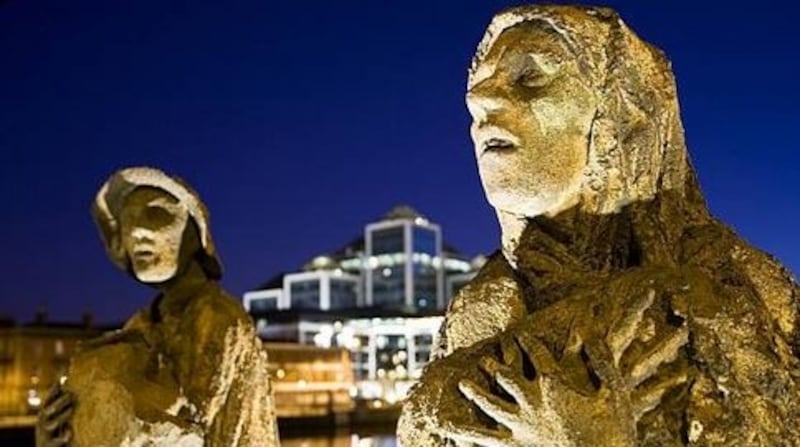More than 15,000 migrants were saved from the Mediterranean by Irish Naval Service personnel between May 2015 and the end of last year. Some day one of those migrants may write the book Jim Callery and His Role in My Rescue.
It was through Callery's work that Ireland's conscience was pricked to action in May 2015 to help those people. In April 2015, a month before the LE Eithne left Haulbowline, Co Cork, on her first trip to the Mediterranean, Callery's daughter Caroilin commented that "while exploring our past we are always conscious that the experience is someone else's present".
She was one of the group which had recently taken part in a 155km walk from the Famine Museum at Strokestown House in Co Roscommon to Dublin. Callery bought the house 36 years beforehand, and funded it and its Famine Museum.
Walk participants, in period costume, were commemorating an incident in 1847 which saw 1,490 starving tenants from the Mahon estate in Strokestown marched to Dublin, marshalled by bailiffs, to board the ship Naomi for Canada. "Seven hundred of them died at sea," Caroilin Callery recalled.
As she and the others began their walk, she said she received a “gut-wrenching” text message stating that 700 migrants had drowned off the coast of Libya. The parallels were undeniable.
As they arrived at their destination, the Jeanie Johnston tall ship on Custom House Quay, the group were met by Callery, his wife Adeline, and Minister for Heritage Heather Humphreys, who said: "You've brought life to history, and history to life."
Memorial wall
The previous May, Taoiseach Enda Kenny unveiled a memorial wall at Strokestown House bearing the names of the 1,490 people marched to Dublin to board the coffin ships, which were organised by landlord Major Denis Mahon.
When the ships – “rampant with cholera and typhus” – arrived in Canada, “the dead and living were huddled together”, and bodies were pulled from the ships with boat hooks, Kenny told an audience of ambassadors , TDs and returned emigrants.
Take a bow, Mr Callery, for reminding us of something about which we needed reminding
About a year later, on May 15th, 2015, Kenny highlighted Ireland's familiarity with such tragedies. Speaking to the crew of the LE Eithne as it prepared to leave Cork on that first mission to the Mediterranean, he said "it is in our history and personality and in our DNA in Ireland having dealt with coffin ships after the time of the Famine and the Great Hunger".
Take a bow, Mr Callery, for reminding us of something about which we needed reminding.
When Callery took over Strokestown House in 1979, there were no official commemorations of the Famine. We had buried it and moved on.
He was not an obvious candidate to bring the past back to life. He worked as a farmer on leaving school, and opened a filling station in Strokestown where he sold used cars and tractors. In 1968, he got a break, becoming a Chrysler dealer.
By the mid-1970s his Westward motor group was doing well, but his coup de grace came in 1976 when he was appointed Irish distributor for Scania trucks.
This was not without stealth. He heard two senior Scania executives were staying at a hotel in Ballsbridge, Dublin, and set off from Roscommon at an unearthly hour and waylaid the two Swedes in the hotel at 7am, convincing them to come west with him. They did, and the rest is history.

Documents
Through those years of robust growth he clashed again and again with the Pakenham Mahon family at Strokestown Park as his business was so close to their estate. He later heard the estate was being sold, and bought it from Olive Hales Pakenham Mahon in 1979 for about IR£400,000 (excluding contents) prior to auction.
Callery was taken aback when he discovered more than 55,000 documents, many relating to the Famine, in the house. He felt he had been entrusted with safeguarding a legacy, and the National Famine Museum later emerged.
One of the first things he found among those documents was an 1846 petition from his own townland of Cloonahee – a plea from the tenants for help as they faced another winter of starvation. “We cannot much longer withstand their cries for food,” they wrote.
He found the document in the “smoking room” of the crumbling house, which he has since restored. “I was speechless and, I can tell you, I read it more than once.”
“We are not for joining in anything illegal or contrary to the laws of God or the land unless pressed to by hunger,” the tenants had warned.
Financially it's been a bit of a disaster. The constant cost of repairs, refurbishment and upkeep are a nightmare
The Famine Museum has many such documents, as well as records of torrid events from the period, including the assassination of Mahon a year after he sent hundreds of tenants to their deaths on the coffin ships.
Dug the hole myself
Callery said of Strokestown House recently that “financially it’s been a bit of a disaster. The constant cost of repairs, refurbishment and upkeep are a nightmare. That said, I dug the hole myself.”
Then, in October 2015, the Taoiseach announced that Strokestown Park and National Famine Museum would be operated by the Irish Heritage Trust for the following decade. It was a much needed and deserved fillip.
News last week that Callery has won one of the major European awards in the heritage field, – a 2017 European Union Prize for Cultural Heritage/Europa Nostra Award for dedicated service to heritage (through his work on the museum and archive at Strokestown House) – will have delighted many.
That he has also been selected as a candidate for the Public Choice Award to be be announced in Turku, Finland, next month will underline that satisfaction.
Votes can be cast online at http://vote.europanostra.org/








